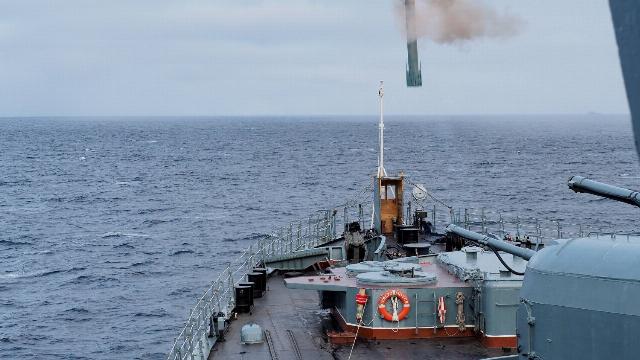Military expert Dmitry Boltenkov — on the importance of the Arctic campaign of a detachment of ships of the Northern Fleet
A detachment of ships of the Northern Fleet, which embarked on an Arctic campaign this week, will conduct a number of exercises, in particular, they will land troops on the polar coast. The main purpose of the campaign is to ensure the safety of maritime navigation and other economic activities of Russia in the Arctic zone, said the commander of the detachment, Captain 1st rank Stanislav Varik. The route will pass through the seas of the Arctic Ocean, including areas where the Northern Sea Route is used. This event is aimed at ensuring military security, controlling key transport arteries and confirming Russia's ability to effectively protect its interests in the polar latitudes. The North Sea team will work out the tasks of defending Russia's island and continental territories in the Arctic. Why are such trips of great importance for our country?
The composition of the detachment is traditional and includes the large anti-submarine ship Severomorsk, the large amphibious assault ship Alexander Otrakovsky, the rescue tugboat Pamir and the tanker Sergei Osipov. The Northern Fleet has only three large anti-submarine and large amphibious ships, so there is little choice of participants. Not so long ago, the patrol icebreaker Ivan Papanin joined the fleet, apparently, it will go to the Arctic as part of the next cruise.
Russian naval formations in the North appeared during the First World War, when it became necessary to defend convoys with weapons traveling from the Entente countries to the ports of Arkhangelsk and the newly built seaport of Murmansk.
Then, in the Soviet years, the active development of the northern Arctic territories in the national economy began, primarily in the extraction of valuable minerals. The topic of the so-called northern delivery appeared, when goods and products were delivered to the ports of the northern rivers, for example, to the port of Dudinka on the Yenisei. Further, these cargoes arrived along the rivers to settlements where there is simply no other type of transport. The development of the Northern Sea Route has also begun. As a result, during the Great Patriotic War, the problem arose of defending such sea routes from the German naval forces. After the end of the war, the tasks of the Northern Fleet changed. Now he had to conduct combat operations in the Central and North Atlantic, solving combat missions to isolate Europe from military assistance from the United States. The defense of sea transport routes in wartime falls on the Arctic Flotilla deployed on the basis of the Severodvinsk naval base. Its main part, as in the war years, was to be made up of mobilizable civilian vessels. As such, voyages by warships of the Soviet-era Northern Fleet along the Northern Sea Route were extremely rare and amounted to rare ship crossings to the Pacific Fleet.
In recent years, Russia has been promoting the Northern Sea Route as a way to deliver goods faster from West to East and back. It is shorter than the traditional route through the Suez Canal. In addition, the gas and oil resources of the maritime economic zone are being actively developed, LNG production plants and new seaports have been created and are being built. Russian military bases with airfields and positions of anti-aircraft and coastal missile systems are located on the islands of the Arctic Ocean. All this required the creation of Arctic troops, constant development of methods and methods of warfare in northern conditions.
Russia has invested a lot of effort, sweat and blood into the development of these territories and, accordingly, considers the waters of the Arctic its own. Of course, this is not liked by a number of countries that demand maximum openness of sea routes. Therefore, Russia needs to conduct military development of the waters of the Arctic Ocean by surface, underwater and aviation means. It must be permanent: some people go into reserve, others replace them, practical experience must be gained, waters must be studied, hydrology and the outlines of the coast are changeable. In fact, such campaigns can be compared to a wrestler practicing techniques over and over again in order to work correctly at the right moment.
In this regard, sending a large anti-submarine ship as a means of combating surface and underwater enemies looks like a necessary measure to practice protecting economic waters and escorting convoys. Do not forget that countries unfriendly to Russia are actively trying to explore the waters of the Russian part of the Arctic Ocean with their ships and submarines. And we need to be ready to conduct military operations in waters so harsh in terms of hydrometeorology and ice.
Why, then, is it necessary to send an amphibious assault ship? It is a means of transporting troops and military equipment primarily over long distances to places where there is simply no land transport, but only sea or air transport. In the north, there are enough places where military equipment can only be delivered by sea. Airborne units can also be parachuted through the air. Therefore, it is necessary to practice the transfer of forces by sea.
In addition, other elements of combat training are practiced during such campaigns. Last year, for example, the detachment took part in the Ocean-2024 exercise, operating against the forces of the Pacific Fleet. It is possible that similar events will be held this time. Already these days, the detachment is participating in the command and staff training of the Northern Fleet headquarters for command and control during the defense of military and civilian infrastructure facilities on the Arctic coast of Russia. Up to 2 thousand people, about 60 units of military and special equipment, up to 8 aircraft, 14 ships, submarines and support vessels are involved in the participation.
The editorial board's position may not coincide with the author's opinion.

